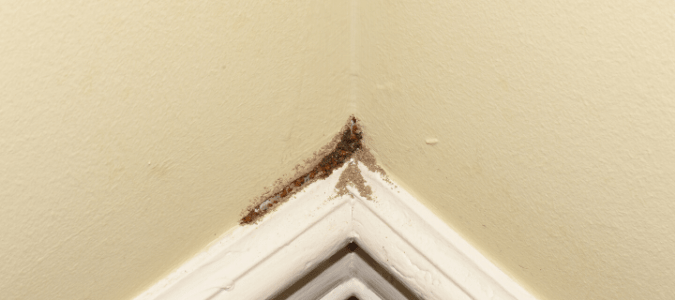
Termites are stealthy, destructive pests that cost homeowners in the U.S. billions of dollars in damage each year. Part of the reason these pests are capable of causing such extensive damage is that they tunnel underground and out of sight. However, there are a few signs that a homeowner can look out for that indicate the presence of termites, including termite frass, which is the technical term for this insect’s waste products.
Other common signs to look out for that can indicate that you have termites on your property include:
- Flying swarmers
- Piles of wings
- Mud tubes
- Cracking wood or wood surfaces that sounds hollow when you knock against them
Subterranean termites mix their feces with saliva and chewed wood to make their tunnels, called mud tubes. These passageways are most commonly found around the foundation of your home or along walls. About as thick as a pencil, mud tubes are typically brown, or are similar in color to the wood surrounding the tubes. Since subterranean termites are rarely above ground, as they require moisture to survive, these tubes provide these insects with the moisture they need to keep eating away at the wood in your home until they are discovered.
If you notice what you suspect are mud tubes around your home, break off a center section and throw it away. Wait a few days to see if the tube is left as-is or rebuilt. Termites may abandon tunnels, but if they are still using them, the tube will be rebuilt quickly. If you come back to find that the tube has been rebuilt, you’ll want to take action quickly. Damage to your foundation could be costly, and most homeowners with termites usually only find out about an infestation once significant damage has already been done. To remove termites quickly and completely, you need to enlist the help of a pest control professional. The faster you do this, the less costly the damage will be to your biggest investment.
Drywood termites are more likely to leave behind excrement that you might come across in the form of a pile of six-sided pellets. These waste products can resemble coffee grounds or sawdust. Frass can be tan to very dark brown in color and are often found in mounds. As their name indicates, drywood termites have adapted to drier environments, so you can find these termites above ground in older structures with high humidity and homes that are exposed to moist soil. Drywood termites can infest nondecayed or sound wood, although they also can be found in stumps, logs, or decaying and damp wood outside.
If you have discovered what you imagine is termite frass, or any other possible signs you have termites, you probably have more questions regarding these destructive pests. In this post, we’ll answer some of the most common queries homeowners have, including how to identify eggs, whether to be alarmed if you find dead termites, what to do if you find termites in your firewood and how infestations begin.
Speaking of beginnings, let’s start with the first part of a termite’s life cycle: the egg.
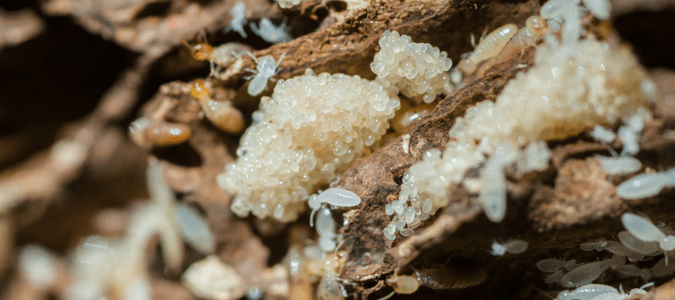
What Do Termite Eggs Look Like?
Ever wondered what termite babies look like? Or termite eggs? If you have asked yourself either of these questions, you should know that termite eggs look like tiny jelly beans or caviar that are a white or yellow color. While they’re not a pleasant sight to see, most homeowners don’t usually find these eggs, as they are located deep within a nest. When an egg hatches, it becomes a termite nymph. Young termites are a pale cream or white color with three pairs of legs, as you can see above. Termites may develop into one of three castes as they mature: workers, soldiers or reproductives.
Worker termites make up the majority of the colony. Their job is to forage for food, feed the other castes, groom the queen and maintain and build mud tubes. Soldier termites protect the colony from invaders, such as ants and other termites. The reproductives, as you might suspect, are responsible for producing offspring.
Once the colony has reached full maturity, reproductives develop wings and become alates. When the conditions are right, male and female alates fly out of the nest to pair up and start a new colony. They lose their wings, find shelter and begin to reproduce. As they start a new colony, the female takes on the role of a queen.
On her first attempt, a new termite queen will only produce six to twelve eggs. Once the queen pushes out the eggs, they are removed and placed in nests. Since these termite eggs are located deep within the termite nest, you won’t find out you have a termite infestation by simply stumbling upon a clump of termite eggs. Although the termite queen starts off by producing a small number of eggs, she will slowly start to produce more and more. Once established, termite queens will lay over 500 eggs every year.
But, what about the end of the termite life cycle? Are dead termites a sign of an infestation?
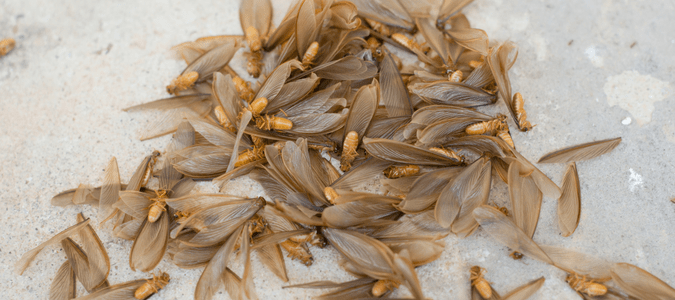
Dead Termites In House: What Does It Mean?
If you’ve been finding dead termites around windows, doors and other light sources, you may be wondering if this is just the start of the infestation or if an infestation has already taken place. Unfortunately, dead termites is a sign you have termites. As mentioned above, when the colony has grown to full maturity, reproductives fly out of the nest to create a new colony. As these termites swarm out of the nest on the search for a new home, many of them fly towards lights and don’t end up making it to a safe place, which is why you’ll commonly see dead reproductives on window sills and near entryways.
These reproductives need to be in close contact with moist soil. If they are left out in the dry air for too long, they will dry up and die. If you see dead winged termites, do not assume that the infestation has been resolved. Remove dead termites from your house with a broom or vacuum and get in touch with a pest control professional immediately to start a treatment plan.
Since reproductives likely came from an existing colony to start anew, unfortunately, getting rid of swarming termites won’t do anything to stop the current infestation you have. Another thing to keep in mind is that some ant species swarm at around the same time, so you’ll want to make sure to confirm that it is really a termite you are seeing. That’s another reason you may want to enlist the help of a pro.
It’s one thing to find a termite inside your house. But what does it mean to find termites outside?
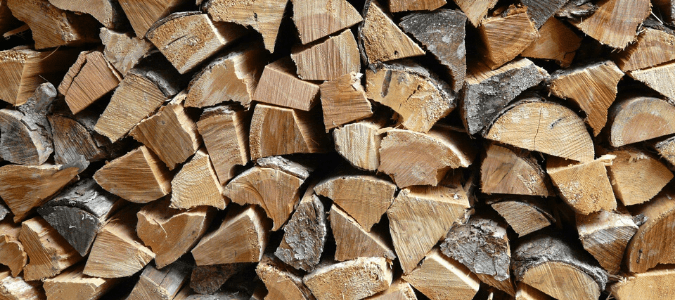
Termites In Firewood: Are They Dangerous?
Termites will eat a lot of wood over the course of their life. More specifically, they will eat a lot of cellulose, which is an organic fiber found in plant and tree matter. Because of this, when you bring firewood into your home, you may accidentally bring a few hungry termites along with it.
Does this mean that you’ve just unwittingly infested your home? Not necessarily. Luckily, if you do bring termites into your home through firewood, your chances of an infestation are low, as queens won’t be hanging out in firewood—they’re most likely living in nearby soil producing eggs for the colony. The termites who are most likely to be in the wood are workers and maybe a soldier or two which can’t reproduce.
That said, most people would probably rather not have termites in their firewood at all. You can identify termites in your firewood by looking for mud tunnels. These may appear inside or outside the log itself. If you do identify these tubes, dispose of the firewood far from your home. Don’t use an insecticide to remove termites from firewood, either. Burning these chemicals later could pose serious risks to you and your family.
Furthermore, termites aren’t the only pests who enter your home through firewood. Carpenter ants and various forms of beetles may also hitch a ride on chopped wood. If you’re not sure what bug you’re dealing with, look for the telltale signs of termites.
No matter what, it’s always a good idea to keep firewood away from your home—at least five feet, and preferably off the ground. Creatures that munch on or live in firewood might look for other yummy or comfortable things nearby. When you keep firewood stacked away from your house, it decreases the likelihood that these insects might hop over to your home’s foundation or framing. To keep bugs away from the firewood itself, use a protective covering to keep it dry. Rotting wood or excess moisture only makes firewood more appealing to termites. And, of course, if you believe that you have an infestation of any type of pest, reach out to a trusted pest control professional.
Now that we’ve reviewed some signs of an infestation, let’s explore the reasons you could have termites.
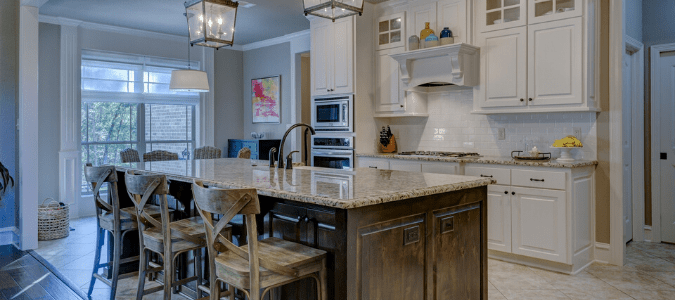
How Do You Get Termites?
Termites require two things to survive: food and moisture. If your home or yard is providing these pests with either, or both, of these things, you could be attracting termites. The termite diet consists of cellulose, which is found in wood, drywall, sheetrock and any other plant matter. Moreover, termites can chew holes through any of these materials to get where they want to go. Cracked foundations, puddles of moisture near baseboards and door frames and any other places where moist soil or vegetation is in close contact with your home are common entryways for these pests. If termites find an area with the right combination of food and moisture, they will set up shop.
If you want to prevent termite infestations, go around your house and seal any cracks that could let in termites. Pest control professionals can help you look through your property for common problem areas. Knowing what attracts these pests and how to prevent them is extremely important, because once termites chew holes in your foundation or framing to get inside, they will continue to feast on your home, often 24 hours a day. Often, this type of invasion goes unnoticed for months or longer, and termite populations can grow very quickly, compounding the damage.
ABC Can Control Termites On Your Property
Termites can cause extensive and costly damage to a home. At the first sign of a termite infestation, contact the termite control specialists at ABC Home & Commercial Services. Our knowledgeable professionals will be able to quickly locate the colony and get to work on eliminating all of the termites on your property. Afterward, we can put measures in place to ensure that your property will be protected against future problems.
